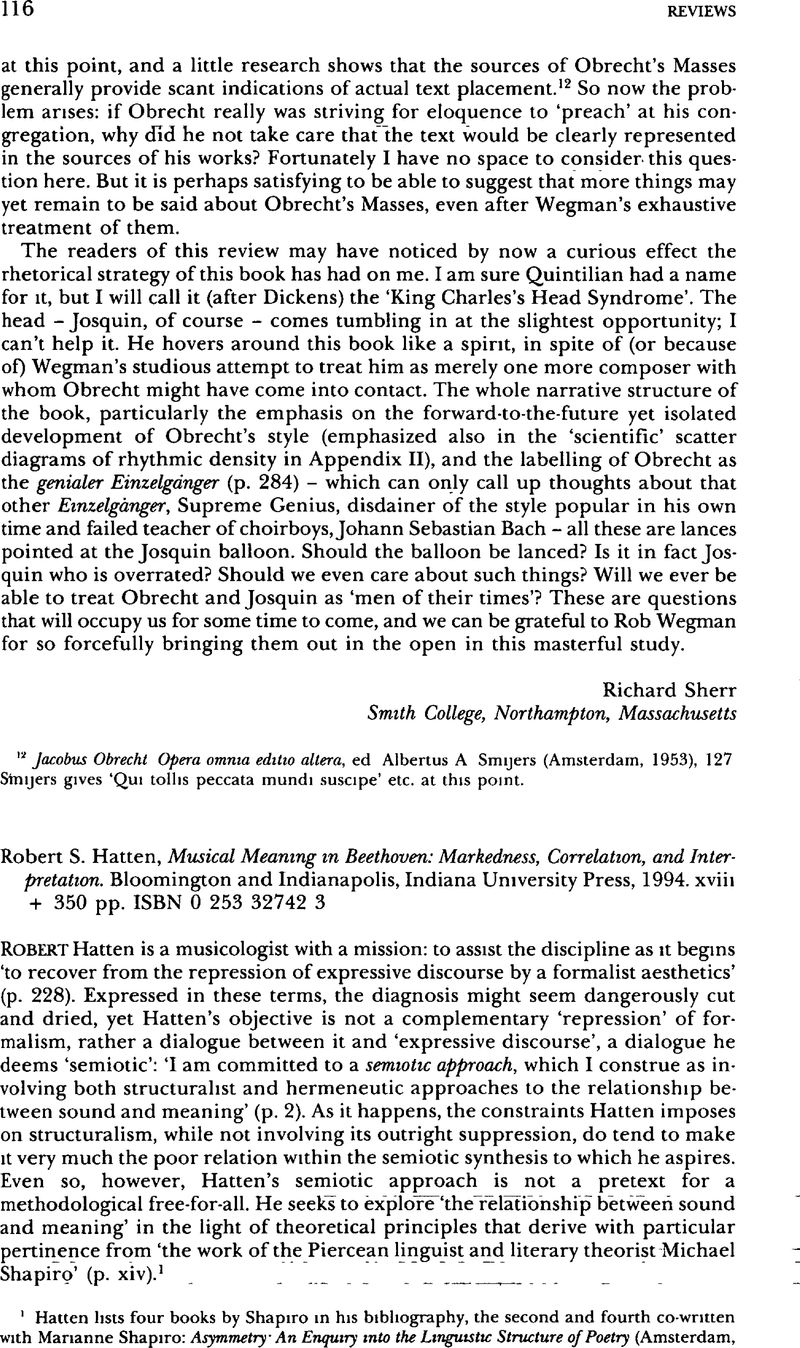Published online by Cambridge University Press: 01 January 2020

1 Hatten lists four books by Shapiro in his bibliography, the second and fourth co-written with Marianne Shapiro: Asymmetry An Enquiry into the Linguistic Structure of Poetry (Amsterdam, 1976), Hierarchy and the Structure of Tropes (Bloomington, 1976), The Sense of Grammar (Bloomington, 1983), Figuration in Verbal Art (Princeton, 1988). Among salient topics and techniques Hatten relates to Shapiro's work are ‘correlation’ and ‘markedness’ Correlation is defined as ‘stylistic association between sound and meaning in music; structured (kept coherent) by oppositions, and mediated by markedness’ (p 289). Markedness is defined as ‘the asymmetrical valuation of an opposition … Marked entities have a greater (relative) specificity of meaning than do unmarked entities. Marked entities also have a narrower distribution, which means that they tend to occur in fewer contexts, and thus (usually) less often than their unmarked opposites’ (pp. 291–2) Hatten also attaches importance to ‘troping’, the concept of ‘figurative meaning in music’, which for him becomes particularly important when ‘two different, formally unrelated types are brought together in the same functional location so as to spark an interpretation based on their interaction’ (p. 295). A useful summary of Hatten's ideas can be found in his ‘Response to Peter Burkholder’, Journal of Musicology, 11 (1993), 24–31Google Scholar
2 Hatten's footnote here draws attention to ‘the positive contribution of an ascending chromatic bass line in contrary motion that accompanies the Db statement of the integrative “second” theme in the recapitulation, mm. 162–4’ (p. 312).Google Scholar
3 See in particular Hoffmann's ‘Review of Beethoven's Fifth Symphony’, first published in 1810 E T A Hoffmann's Musical Writings, ed David Charlton, trans. Martyn Clarke (Cambridge, 1989), 234–51Google Scholar
4 Coker, Wilson, Music and Meaning A Theoretical Introduction to Musical Aesthetics (New York, 1972) Jean-Jacques Nattiez, Fondements d'une sémiologie de la musique (Paris, 1975)Google Scholar
5 See, for example, Lawrence Kramer's claim that ‘the new musicology operates at a critical, if appreciative distance from its objects of study’ (review of Richard Kramer, Distant Cycles Schubert and the Conceiving of Song (Chicago and London, 1994), The Times Literary Supplement, 31 March 1995, 18). For discussions that question the success of some new musicologists in achieving their stated objectives, see Taruskin, Richard, ‘Revising Revision’, Journal of the American Musicological Society, 46 (1993), 114–38, and the exchange between Lawrence Kramer and Gary Tomlinson in Current Musicology, 53 (1993), 18–40Google Scholar
6 Korsyn, Kevin, ‘J. W N. Sullivan and the Heiliger Dankgesang: Questions of Meaning in Late Beethoven’, Beethoven Forum 2, ed. Christopher Reynolds (Lincoln, Nebraska, and London, 1993), 133–74 (p. 172).Google Scholar
7 ‘Adorno's Diagnosis of Beethoven's Late Style’ Early Symptom of a Fatal Condition', Journal of the American Musicological Society, 29 (1976), 242–75; repr in Developing Variations Style and Ideology in Western Music (Minneapolis, 1991), 15–41.Google Scholar
8 See Paddison, Max, Adorno's Aesthetics of Music (Cambridge, 1993), 239Google Scholar
9 Agawu, V Kofi, Playing with Signs A Semiotic Interpretation of Classic Music (Princeton, 1991), 112, 125–6Google Scholar
10 Music Theory Spectrum, 14 (1992), 88–98Google Scholar
11 See Milton Babbitt's contribution to ‘Brave New Worlds’, The Musical Times, 135 (1994), 330–7 (p 333).Google Scholar
12 Music Analysis in the Nineteenth Century, ii, Hermeneutic Approaches, ed Ian Bent (Cambridge, 1994), 1Google Scholar
13 Music Analysis in the Nineteenth Century, 11, ed Bent, 76Google Scholar
14 See Wintle, Christopher, ‘Kontra-Schenker Largo e mesto from Beethoven's Op 10 No 3’, Music Analysis, 4 (1985), 145–82Google Scholar
15 Pascali, Robert, ‘Hearing/Reading Beethoven's Cavatina‘, paper presented at the Conference of the Society for Music Analysis, Lancaster University, 24 September 1994Google Scholar
16 See Dunsby, Jonathan and Stopford, John, ‘The Case for a Schenkerian Semiotic’, Music Theory Spectrum, 3 (1981), 49–53.Google Scholar
17 Kofi Agawu, review of Raymond Monelle, Linguistics and Semiotics in Music (Chur, 1992), Music and Letters, 75 (1994), 120–2 (p 122)Google Scholar
18 See Les écritures du temps Sémantique psychologique de la musique (Paris, 1981) I owe this reference to the article by Jonathan Berger cited in note 20 below.Google Scholar
19 Norris, Christopher, Derrida (London, 1987), 35Google Scholar
20 Berger, Jonathan, ‘Playing with Playing with Signs A Critical Response to Kofi Agawu’, Journal of Music Theory, 38 (1994), 293–313 (p 310).Google Scholar
21 Monelle, Linguistics and Semiotics in Music, 237Google Scholar
22 See notes 6 and 9 above See also Timothy L. Jackson, ‘The Metamorphosis of the Metamorphosen: New Analytical and Source-Critical Discoveries’, Richard Strauss: New Perspectives on the Composer and his Work, ed Bryan Gilliam (Durham, North Carolina, and London, 1992), 193–241.Google Scholar
23 Monelle, Linguistics and Semiotics in Music, 270Google Scholar
24 Ibid.Google Scholar
25 Korsyn, ‘J W N. Sullivan and the Heiliger Dankgesang‘, 173–4Google Scholar
26 Monelle, Linguistics and Semiotics in Music, 124Google Scholar